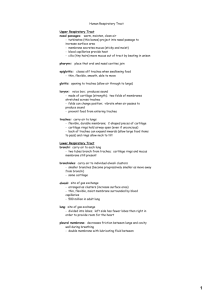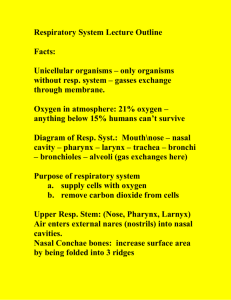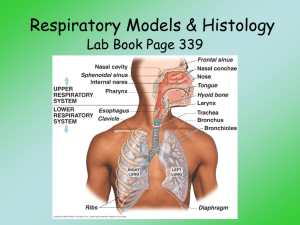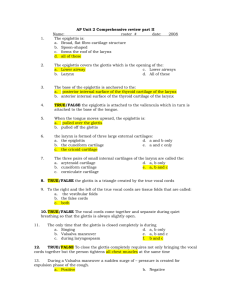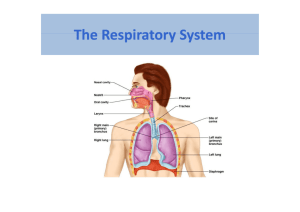Resp Anatomy Lab Manual: 10th ed
advertisement
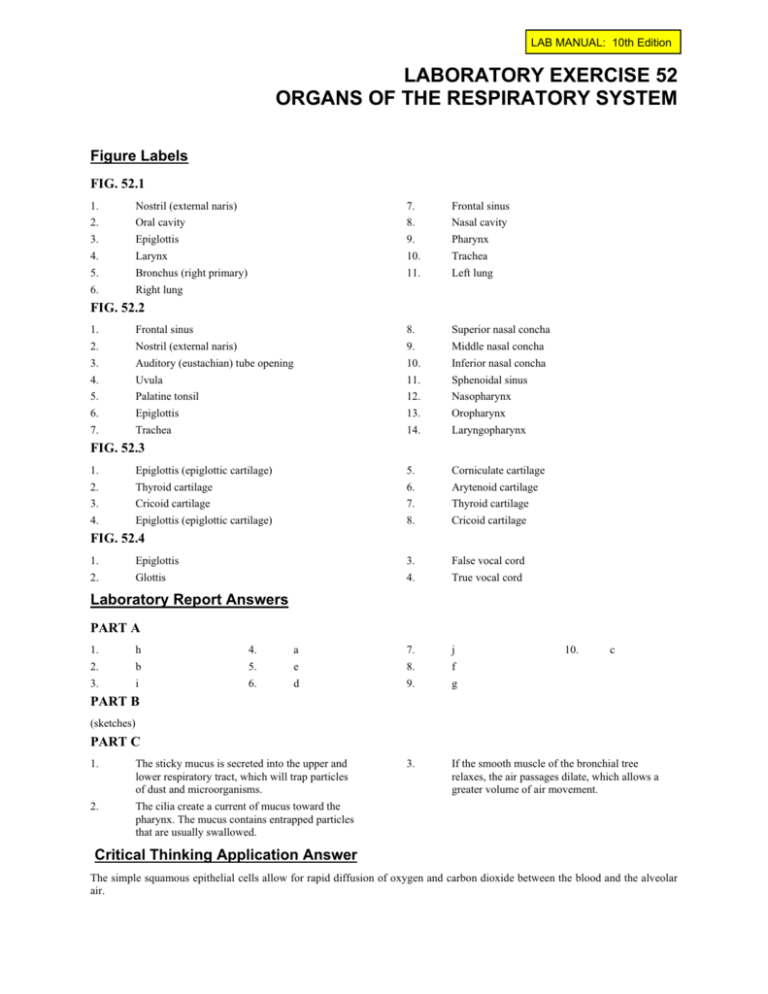
LAB MANUAL: 10th Edition LABORATORY EXERCISE 52 ORGANS OF THE RESPIRATORY SYSTEM Figure Labels FIG. 52.1 1. 2. Nostril (external naris) Oral cavity 7. 8. Frontal sinus Nasal cavity 3. 4. Epiglottis Larynx 9. 10. Pharynx Trachea 5. Bronchus (right primary) 11. Left lung 6. Right lung FIG. 52.2 1. Frontal sinus 8. Superior nasal concha 2. 3. Nostril (external naris) Auditory (eustachian) tube opening 9. 10. Middle nasal concha Inferior nasal concha 4. 5. Uvula Palatine tonsil 11. 12. Sphenoidal sinus Nasopharynx 6. Epiglottis 13. Oropharynx 7. Trachea 14. Laryngopharynx FIG. 52.3 1. Epiglottis (epiglottic cartilage) 5. Corniculate cartilage 2. 3. Thyroid cartilage Cricoid cartilage 6. 7. Arytenoid cartilage Thyroid cartilage 4. Epiglottis (epiglottic cartilage) 8. Cricoid cartilage FIG. 52.4 1. Epiglottis 3. False vocal cord 2. Glottis 4. True vocal cord Laboratory Report Answers PART A 1. 2. h b 4. 5. a e 7. 8. j f 10. c 3. i 6. d 9. g 3. If the smooth muscle of the bronchial tree relaxes, the air passages dilate, which allows a greater volume of air movement. PART B (sketches) PART C 1. 2. The sticky mucus is secreted into the upper and lower respiratory tract, which will trap particles of dust and microorganisms. The cilia create a current of mucus toward the pharynx. The mucus contains entrapped particles that are usually swallowed. Critical Thinking Application Answer The simple squamous epithelial cells allow for rapid diffusion of oxygen and carbon dioxide between the blood and the alveolar air. LAB MANUAL: 10th Edition LABORATORY EXERCISE 53 CAT DISSECTION: RESPIRATORY SYSTEM Laboratory Report Answers 1. The auditory tube allows air to pass between the cavity of the middle ear and the outside environment. As a result, air pressure normally remains equal on both sides of the eardrum. 2. 3. The glottis is the opening at the superior (anterior in cats) end of the larynx. The epiglottis is a flaplike structure that shunts food and liquid away from the glottis during swallowing. The tracheal rings are incomplete as they are in the human. 4. The structure of the primary bronchi and the trachea are similar. 5. The cat has three lobes in each lung. (The third lobe on the right has a fold of mediastinum that is sometimes called a fourth lobe.) The human has three lobes in the right lung and two in the left. The diaphragm is attached to the lower rim of the thorax and to a central tendon. 6. 7. The heart, esophagus, trachea, and thymus gland are found in the mediastinum. These are the same major structures found in the human mediastinum. 2

